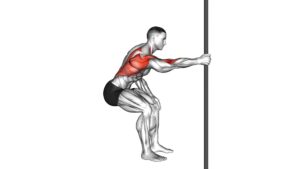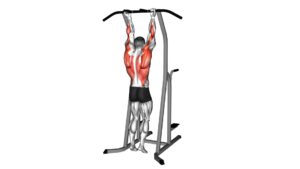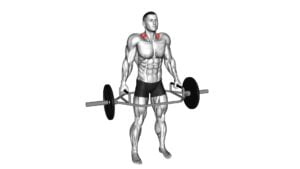Hangback Bar Stretch – Video Exercise Guide & Tips

Are you looking for a new exercise to add to your routine?
Watch This Exercise Video
Try the hangback bar stretch!
This video exercise guide and tips will show you the proper form and technique, as well as modifications for beginners and advanced practitioners.
Avoid common mistakes and maximize the effectiveness of this stretch with expert advice.
Get ready to improve your flexibility and strength with the hangback bar stretch!
Key Takeaways
- The Hangback Bar Stretch improves flexibility, range of motion, muscle activation, and posture.
- Beginners can modify the exercise by starting with a lower bar height or resistance band for support and gradually increasing the difficulty as they improve.
- Advanced practitioners can add ankle weights or a weighted vest for increased resistance and try performing the stretch with one leg lifted off the ground.
- Common mistakes to avoid include using excessive momentum, neglecting proper form, bending at the knees, and shrugging the shoulders.
Benefits of the Hangback Bar Stretch
One benefit of the Hangback Bar Stretch is that it helps improve your overall flexibility and range of motion. Flexibility is crucial for maintaining proper joint function and preventing injuries during physical activity. By performing this stretch, you're preparing your body for exercise and ensuring that your muscles and joints are ready to move freely and efficiently.
Flexibility plays a vital role in your fitness routine. It allows you to perform exercises with a full range of motion, which enhances muscle activation and promotes optimal muscle development. When your muscles are more flexible, they can generate more force, resulting in improved athletic performance.
Additionally, the Hangback Bar Stretch targets the muscles in your back, shoulders, and chest, which often become tight and restricted due to prolonged sitting or poor posture. By stretching these muscles regularly, you can alleviate tension and improve your posture, reducing the risk of developing chronic pain and discomfort.
Incorporating the Hangback Bar Stretch into your warm-up routine can help loosen up your muscles and increase blood flow to the targeted areas, priming your body for more intense exercise. Remember to always listen to your body and perform the stretch within your comfort zone. As with any exercise, consult with a healthcare professional before starting a new routine.
Proper Form and Technique
To perform the Hangback Bar Stretch with proper form and technique, you should position yourself in front of the bar and grasp it with an overhand grip. Common misconceptions about this exercise include hyperextending the back and using momentum to swing back and forth. However, it's important to maintain control and avoid excessive movement.
To start, hang from the bar with your arms fully extended and your body relaxed. Engage your core and slightly tuck your pelvis to maintain a neutral spine. Slowly retract your shoulder blades and squeeze them together, feeling a stretch in your upper back and shoulders.
To progress this stretch, you can perform variations such as adding a knee tuck or a leg raise while hanging from the bar. These variations help to further engage the core and increase the intensity of the stretch.
It is important to listen to your body and only perform the variations and progressions that feel comfortable and safe for you. Remember to breathe deeply throughout the exercise, allowing your muscles to relax and release tension.
Modifications for Beginners and Advanced Practitioners
Adjustments can be made for beginners and advanced practitioners to modify the Hangback Bar Stretch. If you're a beginner, start by using a lower bar height or even a resistance band. This will provide more support and make it easier for you to perform the stretch. As you gain strength and flexibility, gradually increase the bar height or decrease the resistance band tension. This will challenge your muscles and allow you to progress over time. It's important to listen to your body and not push yourself too hard, especially if you're just starting out.
For advanced practitioners, there are several variations you can try to make the Hangback Bar Stretch more challenging. One option is to add ankle weights or a weighted vest to increase the resistance. This will engage your muscles even more and help you build strength. Another variation is to perform the stretch with one leg lifted off the ground. This will require more balance and stability, working your core muscles as well. You can also try holding the stretch for a longer period of time or adding pulses at the bottom of the movement to intensify the stretch. Remember to always maintain proper form and technique, and consult with a fitness professional if you have any concerns or questions.
Common Mistakes to Avoid
If you're a beginner or an advanced practitioner, it's important to be aware of common mistakes to avoid when performing the Hangback Bar Stretch. By avoiding these errors, you can maximize the effectiveness of this exercise and reduce the risk of injury.
Here are some key tips to help you avoid common mistakes:
- Using too much momentum: One common mistake is using excessive momentum to swing your body back and forth on the bar. This not only diminishes the benefits of the stretch but also puts unnecessary strain on your muscles and joints. Instead, focus on controlled movements and engage your core muscles to maintain stability.
- Neglecting proper form: Another common mistake is neglecting proper form during the Hangback Bar Stretch. It's important to maintain a straight spine, engage your shoulder muscles, and avoid shrugging your shoulders. Also, keep your legs extended and avoid bending at the knees. This will ensure that you're targeting the intended muscles effectively.
Tips for Maximizing the Effectiveness of the Exercise
By maintaining proper form and incorporating these tips, you can maximize the effectiveness of the Hangback Bar Stretch.
One common misconception about this exercise is that you need expensive equipment to perform it. In reality, all you need is a sturdy horizontal bar that can support your body weight. You can find such bars at your local gym or even install one in your own home.
Another tip for maximizing the effectiveness of the Hangback Bar Stretch is to ensure that you're using the correct grip. Place your hands shoulder-width apart on the bar, with your palms facing away from you. This grip will target your upper back and shoulders more effectively.
Additionally, it's important to engage your core muscles throughout the exercise to maintain stability and control.
Lastly, focus on your breathing. Take deep breaths in and exhale slowly as you lower yourself into the stretch. This will help you relax your muscles and increase the stretch.
Frequently Asked Questions
How Long Should I Hold the Hangback Bar Stretch For?
When it comes to the hangback bar stretch, it's important to know how long to hold it for maximum benefit. While the specific duration may vary depending on your fitness level and goals, a general guideline is to hold the stretch for about 30 seconds to a minute.
This allows enough time for the muscles to relax and lengthen. Remember to breathe deeply and maintain proper form throughout the stretch.
It's always best to consult with a fitness professional for personalized advice and best practices.
Can I Perform the Hangback Bar Stretch if I Have a Shoulder Injury?
If you have a shoulder injury, it's important to modify the hangback bar stretch to avoid further harm.
The hangback bar stretch can be beneficial for shoulder health as it helps improve flexibility and range of motion.
However, consult with a healthcare professional or physical therapist for specific modifications that suit your injury.
They can guide you on how to perform the stretch safely and effectively without aggravating your shoulder condition.
Is It Necessary to Warm up Before Performing the Hangback Bar Stretch?
Before performing the hangback bar stretch, it's necessary to warm up. Incorporating dynamic stretches before the stretch can help increase blood flow, improve flexibility, and reduce the risk of injury.
For beginners, it's important to modify the hangback bar stretch by starting with a shorter hang time and gradually increasing it as you build strength and flexibility. This will ensure a safe and effective stretch for your shoulders and upper body.
Are There Any Alternatives to Using a Hangback Bar for This Stretch?
Looking for alternatives to the hangback bar stretch?
There are several modifications you can try.
You could use a resistance band or a TRX suspension trainer to achieve a similar stretch.
Another option is to perform a seated or standing backbend to target the same muscles.
Remember to consult with a fitness professional to ensure proper form and technique for any modifications you choose.
Can the Hangback Bar Stretch Help Improve Flexibility in Other Areas of the Body?
The hangback bar stretch can indeed help improve flexibility in other areas of your body. By targeting your back and shoulders, this exercise can increase your overall range of motion and loosen tight muscles. It also promotes proper posture and spinal alignment.
Additionally, the hangback bar stretch can benefit your core strength and stability. Regular practice of this stretch can lead to improved flexibility and better overall physical performance.
Conclusion
In conclusion, the hangback bar stretch is a beneficial exercise for improving flexibility and relieving tension in the upper body.
By following proper form and technique, both beginners and advanced practitioners can safely perform this stretch.
Avoiding common mistakes and implementing the suggested modifications can help maximize the effectiveness of the exercise.
Incorporating this stretch into your routine can contribute to overall physical well-being.

Author
Years ago, the spark of my life’s passion ignited in my mind the moment I stepped into the local gym for the first time. The inaugural bead of perspiration, the initial endeavor, the very first surge of endorphins, and a sense of pride that washed over me post-workout marked the beginning of my deep-seated interest in strength sports, fitness, and sports nutrition. This very curiosity blossomed rapidly into a profound fascination, propelling me to earn a Master’s degree in Physical Education from the Academy of Physical Education in Krakow, followed by a Sports Manager diploma from the Jagiellonian University. My journey of growth led me to gain more specialized qualifications, such as being a certified personal trainer with a focus on sports dietetics, a lifeguard, and an instructor for wellness and corrective gymnastics. Theoretical knowledge paired seamlessly with practical experience, reinforcing my belief that the transformation of individuals under my guidance was also a reflection of my personal growth. This belief holds true even today. Each day, I strive to push the boundaries and explore new realms. These realms gently elevate me to greater heights. The unique combination of passion for my field and the continuous quest for growth fuels my drive to break new ground.



